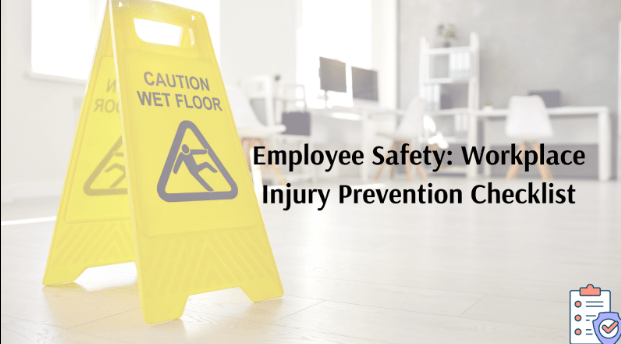Ensuring employee safety should be a top priority for every workplace. Injuries not only pose significant risks to individuals but also have far-reaching consequences on productivity, morale, and legal compliance.
This guide aims to equip you, the employee, with the knowledge and tools to identify potential hazards, demand proper safety protocols, and foster a culture of prevention. We’ll dive into hazard recognition, understanding your rights, demanding proper training, utilizing personal protective equipment (PPE), reporting unsafe conditions, encouraging a safety culture, and seeking support and resources.
This guide provides you with a proactive approach to injury prevention, enabling you to take control of your well-being and mitigate risks before they escalate into serious incidents.
Recognizing Hazards
The first line of defense against workplace injuries lies in your ability to recognize potential hazards. Don’t rely solely on others to identify risks; take the initiative to conduct regular assessments of your work area. Be vigilant and look for slip, trip, and fall hazards, unsafe equipment or machinery, exposure to harmful substances, ergonomic issues, and any other factors that could jeopardize your safety.
Conducting your own job hazard analyses can help you identify specific risks associated with your tasks and responsibilities. Remember, no job is too routine or mundane to warrant a comprehensive safety evaluation. By adopting a proactive approach and staying alert to potential dangers, you can take the first step toward preventing injuries before they occur.
Understanding Your Rights
As an employee, you have fundamental rights guaranteed by the Occupational Safety and Health Act (OSHA) and other labor laws. Familiarize yourself with these regulations, as knowledge is power when it comes to advocating for your safety.
If you suffer a workplace injury, it’s crucial to understand your rights to compensation and support. Workers’ compensation laws vary by state, so understanding your state’s regulations is essential. For instance in California, employees must be provided with benefits for medical treatment and wage loss by their employers.
Consulting with workers compensation lawyers Los Angeles, who specialize in California’s unique regulations, can efficiently guide you through the claims process to ensure you receive the benefits you’re entitled to. Seeking their advice is important if your employer disputes your claim or if you’re unfamiliar with California’s workers’ compensation laws.
Know your right to a safe and healthy working environment, the right to report unsafe conditions without fear of retaliation, the right to receive proper safety training, and the right to access injury and illness records.
Educate yourself on the specific OSHA standards that apply to your industry, as well as any state or local regulations that may provide additional protections. By understanding your rights, you can demand compliance with safety regulations, ensuring a work environment that prioritizes your well-being.
Demanding Proper Training
Comprehensive safety training should be a non-negotiable aspect of any job. If proper training programs covering emergency procedures, equipment usage, and hazard awareness are not provided, you have the right to demand them.
Ensure that the training is tailored to your specific job responsibilities and that you fully understand the protocols in place. Don’t hesitate to ask questions and seek clarification on any aspect of the training that is unclear.
Proper training not only equips you with the knowledge to identify and mitigate risks but also empowers you to take proactive measures in case of an emergency. By demanding thorough and ongoing training, you can enhance your ability to navigate potential hazards and respond effectively to any safety-related incidents.
Utilizing Personal Protective Equipment (PPE)
In many workplaces, the use of Personal Protective Equipment (PPE) is essential for minimizing the risk of injuries. If your job requires PPE such as hard hats, safety glasses, gloves, or respiratory protection, insist on receiving the proper equipment. Never compromise your safety by working without the necessary PPE, even if it means refusing to perform tasks until the appropriate gear is provided.
Additionally, ensure that you receive comprehensive training on how to properly use, inspect, and maintain your PPE. Improper use or ill-fitting equipment can diminish its effectiveness, leaving you vulnerable to potential injuries. Remember, PPE serves as your last line of defense against hazards that cannot be eliminated through other means, so treat it with the utmost importance.
Reporting Unsafe Conditions
If you identify unsafe conditions or practices within your workplace, it is crucial to report them immediately. Advocate for an anonymous, non-punitive reporting system that allows you to voice your concerns without fear of retaliation. Document all instances of unsafe conditions, including dates, times, and specific details, to build a strong case for remedial action.
Hold responsible parties accountable for addressing and rectifying any reported issues promptly. If they fail to take appropriate action, do not hesitate to escalate the matter to higher authorities, such as the Occupational Safety and Health Administration (OSHA) or labor unions, if applicable.
Remember, your safety should never be compromised, and reporting unsafe conditions is not only your right but also your responsibility to protect yourself and your coworkers.
Encouraging a Safety Culture
While maintaining a safe work environment is a shared responsibility, you can play a vital role in fostering a culture of safety. Engage with your colleagues and encourage open discussions about safety concerns, best practices, and potential improvements. Promote a mindset of prioritizing safety over productivity or shortcuts, and challenge any practices that compromise worker well-being.
Lead by example and demonstrate a commitment to following safety protocols, using PPE correctly, and reporting any hazards or incidents. Your actions can inspire others to adopt a similar safety-conscious approach, creating a ripple effect that strengthens the overall safety culture within your workplace.
Seeking Support and Resources
If proper safety measures are not adequately addressed or if you have experienced a workplace injury, do not hesitate to seek support and resources. Contact your local OSHA office or state labor department to file complaints, report violations, or seek guidance on your rights and available assistance.
Consult with worker advocacy groups, legal aid organizations, or personal injury attorneys if you need representation or legal assistance. Remember, you are not alone in your fight for a safe working environment, and there are organizations dedicated to protecting the rights and well-being of employees like yourself.
Proactive vs. Reactive Approach to Safety
| Proactive Approach | Reactive Approach |
| Identifies potential hazards before incidents occur | Addresses safety concerns after incidents have happened |
| Emphasizes preventive measures and employee empowerment | Relies on initiatives from others |
| Fosters a culture of continuous safety awareness | Focuses on reactive measures and compliance |
| Encourages open communication and reporting of concerns | Lacks transparency and employee involvement |
| Prioritizes long-term safety and well-being | Prioritizes short-term fixes and damage control |
By adopting a proactive approach to workplace safety, you can take control of your well-being and mitigate risks before they escalate into serious incidents. This approach not only protects you but also sets a positive example for your colleagues, ultimately creating a safer and more productive work environment for all.
Conclusion
Implementing a comprehensive workplace injury prevention strategy is essential for safeguarding your well-being as an employee. You can make a safe work environment by spotting hazards.
You can do this by knowing your rights, asking for proper training and equipment, reporting unsafe conditions, fostering a safety culture, and seeking support when needed. Remember, prioritizing your safety should be a collective effort, and this guide serves as a roadmap to empower you in that pursuit.
Frequently Asked Questions
-
What should I do if proper safety training or PPE is not provided?
File a complaint with OSHA, document non-compliance instances, and seek help from worker advocacy groups to ensure your rights to proper training and PPE are upheld.
-
Can I face retaliation for reporting unsafe working conditions?
No, it’s illegal to face retaliation like termination or harassment for reporting unsafe conditions. File a whistleblower complaint with OSHA if you face retaliation.
-
What resources are available if I suffer a workplace injury?
Seek medical care, report the incident, explore workers’ compensation benefits, consult organizations like NIRC for claims guidance, and consider consulting a personal injury attorney.


 Nominate someone special for the 2025 Pump It Up Magazine Awards and let's recognize their hard work! Click here.
Nominate someone special for the 2025 Pump It Up Magazine Awards and let's recognize their hard work! Click here.











 Subscribe to our newsletter now and get exclusive early access, behind-the-scenes updates, and special offers delivered straight to your inbox!
Subscribe to our newsletter now and get exclusive early access, behind-the-scenes updates, and special offers delivered straight to your inbox! SUBSCRIBE NOW
SUBSCRIBE NOW